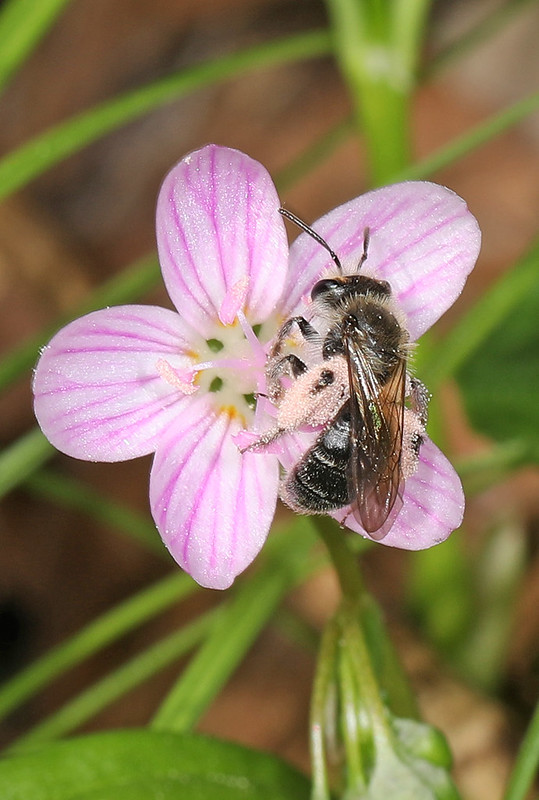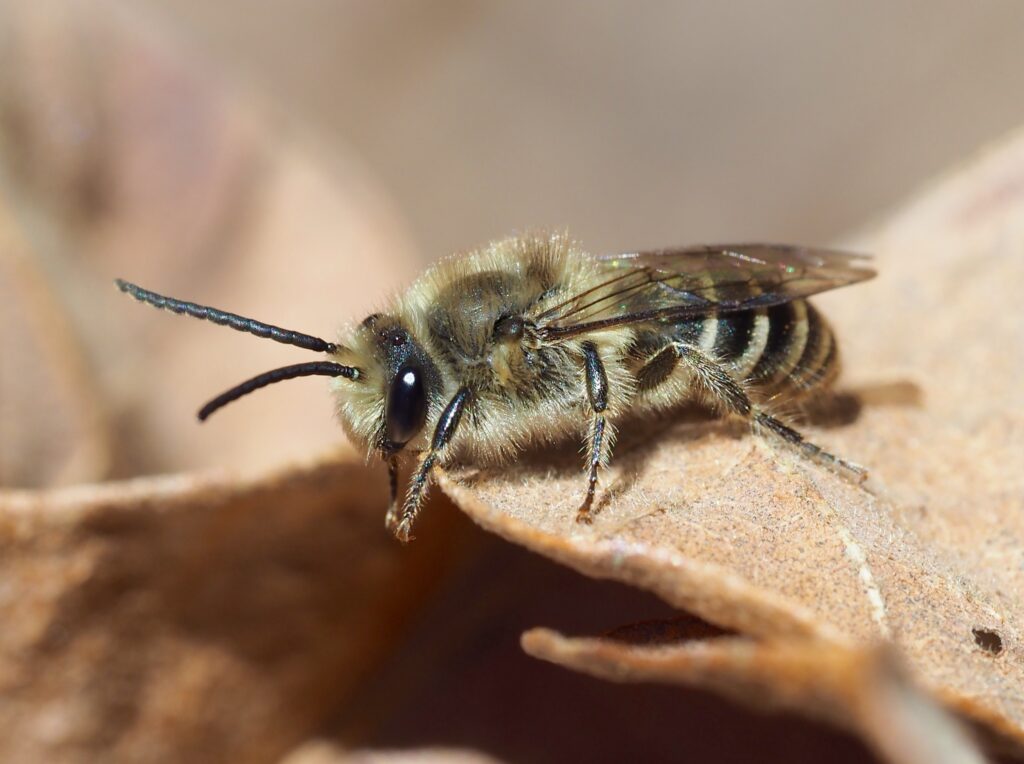Give it Up for the Ground Nesters
Here in Maryland, we are in the beginning throes of ground-nesting bee season. You might be surprised to learn that there are over 440 species of bees that have been documented in Maryland and that most of them nest in the ground.
When most people think of a bee, they envision the honeybee which has had an amazing PR campaign through the years. To me, the honeybee serves a role in agriculture, but it isn’t important for our natural systems. In some cases, honeybees can actually be harmful to other bee species, competing for limited resources while also spreading disease. A discussion on honeybees is warranted for another day, but today, we’re going to give it up for the ground nesters.
As mentioned earlier, ground-nesting bees encompass the majority of bee species found in Maryland. The ground-nesting bees are mostly solitary nesters meaning that they do not form social colonies with division of labor. Because of this, solitary bees have a lot of work to do all by themselves. Usually, the females pull the weight of the work and effectively are hardworking single Moms keeping the species going. While the majority of ground-nesting bees are solitary, they often will aggregate in locations that have prime habitat. For many, these locations are sandy areas close to a preferred food source. This aggregation behavior can cause alarm with some people, though.

In Maryland, bees in all four families have members that are solitary and nest in the ground. For this blog, I’m going to just focus on three families: Andrenidae, Colletidae, and Halictidae as they often are lesser known than the Apidae family. For many solitary bee species, they have active periods that only last a few weeks above ground while the rest of their lifecycle occurs underground.
As mentioned before, the females often are in charge of the majority of the work from building the nest, provisioning it with food, and then laying eggs all in a short amount of time following breeding. I often joke that these females don’t have any time to sting you! The truth is that they lack the aggression seen in social species, and the venom they possess is designed to defend themselves against other bees/wasps (Hymenoptera) or other insect predators. So, even if they were to sting a human, the venom would cause little reaction as it is not meant to deter mammals.

Andrenidae
Andrenids are affectionately known as the mining bees, and well, that’s what they do! The Andrenid family has just over 100 species documented in Maryland. One of the more recognizable species (and one of my favorites!) is the Spring Beauty Andrena (Andrena erigeniae). As its common name suggests, it is a specialist of spring beauty (Claytonia) flowers which have pink pollen. The Spring Beauty bee carries this pollen on its hind legs and essentially looks like it has pink pollen pants as it flies across the forest floor. Most Andrenids in Maryland will be active April through June. Male in the Andrena genus often sport a distinct mustache (dense hairs) below their antennae, which makes them even more irresistible to me. Andrenids are important pollinators of many of our spring ephemeral flowers like bloodroot, waterleaf, pussytoes, violets, golden alexanders, and more. They also visit woody species, too.

Colletidae
Colletid bees have multiple monikers. You might hear them being referred to as plasterer bees, cellophane bees, and/or polyester bees because the females line their brood cells (nest) with a cellophane-like substance that is actually one of the polyesters. In Maryland, twenty-nine species of Colletid bees have been documented. The most commonly reported ground-nesting Colletid is the Rufous-backed Cellophane Bee (Colletes thoracicus) followed by the Unequal Cellophane Bee (Colletes inaequalis). The Unequal Cellophane Bee is one of the earlier species to become active, with some reports of them being spotted in late January and February in Maryland. Their most active period is late March into April, however. The Rufous-backed Cellophane bee is active in late April through June. Due to their early activity periods, these bees generally visit plants like red maple (Acer rubrum), willow (Salix sp.), and American plum (Prunus americana).

Halictidae
The Halictids are often referred to as sweat bees due to the propensity of some to be attracted to our sweat out in the garden. The Halictids can vary widely with their appearance with some being a gorgeous metallic green color while others are more muted in appearance. This is the largest family of bees in Maryland with 120 species documented. The Pure Green Augochlora (Augochlora pura) is easily recognized due to its bright green to bronze color and widespread occurrence across Maryland. It is one of our earlier flying bees in the spring, but it can also be active throughout the growing season into the fall. Adults will overwinter under rotting logs and bark.

Giving Groundnesters a Hand
Habitat loss and degradation are two major reasons for the decline of many of our wildlife species. Solitary, ground-nesting bees often are persecuted, as well, due to the belief that they will attack and sting like their social cousins. As mentioned earlier, solitary ground-nesting bees are only active for a few weeks at a time, so usually, you can wait them out if you want to use certain parts of your yard without disturbing them. You can also continue to use your yard, too. I’ve seen plenty of ground-nesting bees coexist in the middle of sandy trails, though, I imagine some ladies lose their hard work to collapsed tunnels from walking over them. NEVER dump gasoline or pesticides in the ground to remove ground-nesting bees. Most are nesting in these locations due to the sandy soil. If you really cannot coexist, then simply flood the area with water.
Other actions you can take:
- Plant native plants to your area and be sure to plant in clumps to help reduce the amount of traveling the bees have to do between resources.
- Leave the leaves and skip the fall cleanup.
- Provide open, sandy spots close to your gardens to encourage nesting locations.
- Reduce or eliminate pesticide use.
- Educate others. Share the wonders of these little bees with your friends, family, and neighbors. I love showing people how the females will ‘prairie-dog’ out of their holes in the ground to survey for threats before emerging.
- Embrace the cute! Seriously. They have the most adorable faces.
For More Information:
- WILD at Schools has some great activities to teach about native bees here.
- Heather Holm has a number of resources from planting lists to posters to amazing books to learn about bees and wasps.
- Bees of Maryland Field Guide (PDF)
- MD DNR’s Pollinator page
- MD DNR Bee Friendly Backyard (PDF)
- Pollen Specialist bees of the Eastern US
- National Pollinator Week

Tom Melito
Kerry, congrats on setting up this blog. As expected it is informative, humorous and chock full of useful information. I look forward to reading upcoming blogs. You are a educational dynamo!
Tom